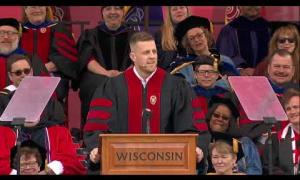How to manage the ‘second conversation’
April 12, 2010
Recent brain research has confirmed what speakers and speechwriters have known forever: No matter how great a speech may seem on the page, success or failure hinges on the delivery. But now, we can understand more precisely why—and we can succeed more reliably.
Every communication—every speech—is two conversations, the content and the nonverbal “body language.” When the two are aligned, a speech and a speaker can be persuasive and powerful. When the two are not aligned, the audience believes the nonverbal message every time.
In my new book, Trust Me: Four Steps to Authenticity and Charisma (Jossey-Bass, 2009), I describe the major implications of this research for communicators and speechwriters. What we’re finding is that gesture originates in the limbic brain, an older part of the brain that developed before the cerebral cortex—the “gray matter” where we do all that conscious thinking.
Here’s how it works. First comes an emotion, or an intent, that begins deep within the limbic brain. It’s unconscious; it’s not part of your conscious thought yet. Next comes a gesture or a movement that is generated in response to that feeling. Finally, a few nanoseconds later, a conscious thought comes along, explaining to ourselves why we’re doing what we’re doing. We think it’s the other way around, but we’re wrong.
You can test this out by watching a conversation or a presentation very closely for the precise moments that gestures begin relative to the thought they’re attached to. If you observe closely enough, you’ll see that the movement begins—the hands begin to wave, for example—a split second before the words come out.
(Indeed, one of the big challenges for communications coaches like me is to coach people without making them look fake. If you get people thinking consciously about their gestures, the unfortunate byproduct is that it slows the gestures down, typically, by a half-second or so. The result is that the gesture comes just a little too late to be persuasive. People aren’t consciously aware of what the problem is, but they’ll say, “That person just didn’t seem real,” or words to that effect.)
More than that, the implication of this intent-gesture-thought-word sequence for communicators is that the second conversation is going on, for the most part unconsciously, between the speaker and the audience, from the moment the speaker gets up to speak. It is more powerful, and it is the conversation that the audience believes when it is in conflict with the spoken word, precisely because it is unconscious, and emotional.
The real leader in the room is selected. The speaker sends out unconscious messages of confidence, energy, and competence—or the reverse. The audience responds or checks out. The spoken word only plays a tiny role at this instinctive level.
When it works, and an audience is brought to its feet cheering, we call it charisma. Or authenticity. When it doesn’t work, we say that the speaker just didn’t have it. Either way, it’s the second conversation that has ruled the day.
Speakers and their communication aids need to work on more than the words. They need to address both conversations. Otherwise, they’re leaving success or failure up to chance.
A speech can never be effectively delivered with no rehearsals, because one message the body sends out right away is “I’m doing this for the first time,” and that’s a fatal error for an executive to commit during a high-stakes speech in front of a critical audience. Communicators, executives will tell you that they’re good on their feet, or that they’re better “winging it,” but don’t believe them. They need to walk the particular stage, they need to see the lights, they need most of all to coordinate the words and the motions so that the two have an even chance of working together when the real speech happens.
But nothing beats rehearsal to help the speaker understand which emotions naturally go with which words. Otherwise he or she might give an unconsciously defensive gesture when they’re saying, “the next quarter will see great improvement,” and the audience will already be placing sell orders on their BlackBerrys.
You can’t leave the second conversation to chance, because it trumps the first one—the content—every time that the two conversations diverge. Rehearse the two conversations with your speaker. It’s essential for effective communication.
Nick Morgan is a political consultant and speaking coach. Formerly editor of the Harvard Management Communication Letter, Morgan has written several books, including Give Your Speech, Change the World and Working the Room—How to Move People to Action through Audience-Centered Speaking. He may be reached at [email protected].



